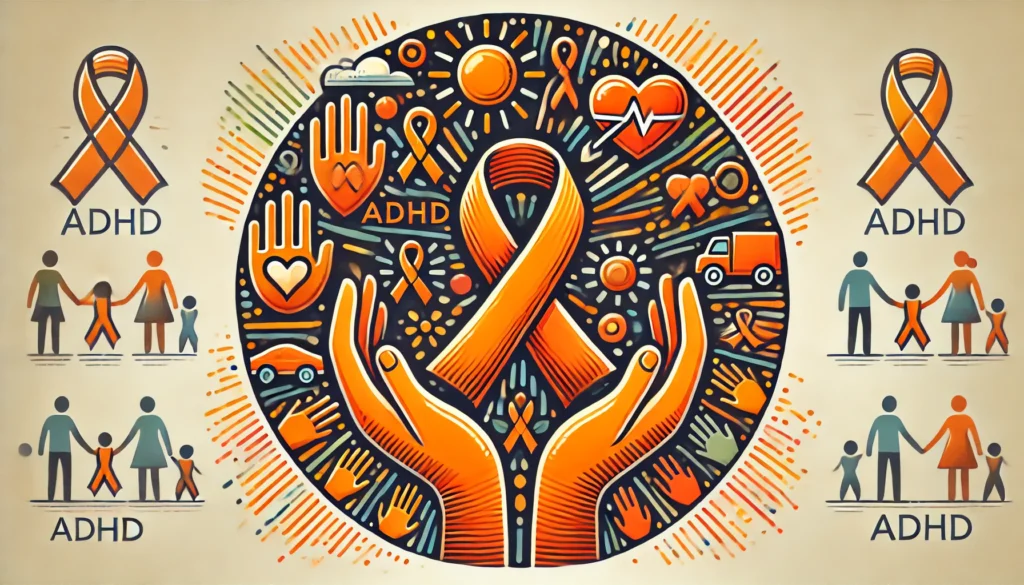What Does the ADHD Symbol Represent?
The ADHD symbol, often represented by an orange ribbon, serves as a beacon of awareness and understanding for Attention Deficit Hyperactivity Disorder (ADHD). This symbol is not only a tool for raising awareness but also an emblem of community, support, and hope for those affected by ADHD. Understanding what this symbol represents helps to foster a greater sense of community and can encourage individuals to seek the support and resources they need to manage their condition effectively.

Origins and Meaning of the ADHD Awareness Ribbon
The choice of the orange ribbon to symbolize ADHD is intentional, with orange representing energy and vitality, which are often abundant in individuals with ADHD. The ribbon itself is a universal symbol of awareness and support, used for various causes. For ADHD, it signifies the vibrant and dynamic qualities of those with the disorder, acknowledging both the challenges and the unique strengths these individuals possess.
The adoption of the ribbon aims to counteract the stigma often associated with ADHD by promoting a positive image and encouraging open conversations about the disorder. It is a call to the public to learn more about ADHD, including its symptoms, treatments, and the experiences of those who live with it. By wearing or displaying the ribbon, individuals show solidarity and support to the ADHD community, spreading awareness and understanding.
This symbol has also become a focal point during ADHD Awareness Month, observed annually in October. During this month, advocates and organizations intensify their efforts to educate the public, share resources, and hold events that highlight the realities of living with ADHD. The orange ribbon is prominently featured in campaigns and materials distributed both online and in communities around the world.
Furthermore, the ribbon serves as a reminder of the need for better resources and research dedicated to ADHD. Advocates often use the symbol in their efforts to lobby for changes in policies and practices that affect individuals with ADHD, from educational settings to workplace accommodations.
As awareness grows, the symbol’s impact deepens, with more individuals recognizing and respecting the challenges and contributions of those with ADHD. It encourages those affected to come forward, share their stories, and seek help, contributing to a more informed and empathetic society.
Representation in Media and Education
The representation of ADHD and its symbol in media and educational materials plays a critical role in shaping public perception of the disorder. Media portrayal of ADHD can significantly influence how individuals with ADHD are treated in society. When the media uses the orange ribbon and discusses ADHD accurately and sensitively, it can lead to greater empathy and understanding, reducing stigma.
Educational campaigns often leverage the ADHD symbol to attract attention and disseminate information. Schools, universities, and health organizations use the ribbon in brochures, posters, and social media campaigns to educate teachers, students, and the general public about recognizing ADHD symptoms and supporting those who struggle with the disorder.
These educational efforts also highlight the diversity within the ADHD community, showing that ADHD affects individuals of all ages, genders, and backgrounds. This inclusive approach helps to dispel myths and stereotypes, presenting a more accurate picture of the disorder.
Moreover, the symbol is used in workshops, seminars, and public talks to signify a safe space where individuals can learn about ADHD without judgment. These settings provide crucial information on coping strategies, treatment options, and ways to support loved ones with ADHD.
Involvement in these educational and media initiatives not only spreads awareness but also empowers those with ADHD. It provides them with the knowledge that they are not alone and that there are avenues for support and advocacy.
The Role of Community and Support Networks
The ADHD symbol also represents the vibrant community of individuals, families, and professionals connected by their experience with ADHD. Support networks, both online and offline, use the ribbon as a symbol of unity and mutual support. These networks provide a platform for sharing experiences, advice, and encouragement, which are invaluable for individuals and families navigating the complexities of ADHD.
Community groups often organize events such as support group meetings, educational workshops, and social gatherings with the ADHD ribbon as a unifying symbol. These events not only serve as educational resources but also as vital support systems that affirm the experiences of those with ADHD, offering strategies for management and opportunities for social connection.
Online forums and social media platforms are also significant in this network, extending the reach of the ADHD community across global boundaries. These digital spaces allow for the sharing of resources, personal stories, and advocacy initiatives, further empowered by the universal symbol of the orange ribbon.
Moreover, the community uses the symbol in fundraising activities to support research into ADHD and the development of new treatments and resources. These funds also help make ADHD resources more accessible to those who might not otherwise afford them, ensuring broader support and treatment coverage.
The solidarity and shared purpose represented by the ADHD symbol enhance the collective strength of the community, making it a powerful force in the lives of those affected by the disorder.
For individuals looking to connect with resources or find professional help, platforms like Lumende provide access to psychologists and psychiatrists who specialize in ADHD. Using these services can help individuals better manage their ADHD symptoms and improve their quality of life. The ADHD symbol is more than just a ribbon; it is a lifeline that connects individuals to the broader narrative of acceptance and understanding, encouraging a proactive approach to managing the disorder and enhancing overall well-being.

 English
English
 Deutsch
Deutsch Français
Français